

The gumoil process « Gumoils. Writer and photography / Kelly Wrage Kelly Wrage has been working with gumoil after being introduced to the process by Cotton Miller in one of Christopher James’ workshops.
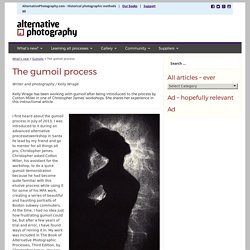
She shares her experience in this instructional article. I first heard about the gumoil process in July of 2013. I was introduced to it during an advanced alternative processesworkshop in Santa Fe lead by my friend and go to mentor for all things alt pro, Christopher James. Christopher asked Cotton Miller, his assistant for the workshop, to do a quick gumoil demonstration because he had become quite familiar with this elusive process while using it for some of his MFA work, creating a series of beautiful and haunting portraits of Boston subway commuters. The process was developed in 1990 by painter, printmaker and photographer, Karl Koenig, who lived and worked in New Mexico. The process, in brief The gumoil process begins with a positive image on transparency film. The positive transparency Contrast in gum solutions M.
Gumoil printing - the method for producing photos in gumoil technique. Gumoil printing was introduced in the 90th of the last century by American photographer Karl Koenig.

Gumoil or Gumoil printing is the method for producing photos with gum, chromium salts and oil paints. It's painstaking and very expressive photographic method that combines unique author's point and documentary photography. Through the use of materials for art works - cotton paper and oil paints, archival photos have unique properties that are comparable to paintings on canvas. Nevertheless, Gumoil print is the alternative photographic process. Print photos in Gumoil technique requires a positive image printed on the film. Such paintings erase time. The work that the photographer spends on getting the end result gives the picture special properties. A Silver Thread – Lynn Bailey. Had a thoroughly exhausting day at the Devon Guild of Craftsmen (Thursday 23rd June).
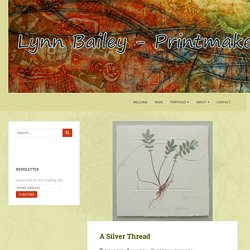
It’s fascinating being part of the selection committee and I always learn an awful lot from the other craft specialists. It is exhausting because it tends to be a very long day and we all feel very responsible about how we select the pieces that are going to go in the exhibition and what isn’t. There’s strict criteria and we have to justify every decision. Today we were selecting for the summer show which is has it’s launch on Friday 1st July 6-8pm. The title for the show is A Silver Thread and it is to celebrate the Devon Guild having been at the Riverside Mill in Bovey Tracey for 25 years. It seemed even more of the member’s pulled the stops out for this summers’ exhibition this year. As a committee member, I had to leave the room when my pieces were being discussed, and I was very grateful not to be left waiting outside too long before being called in to hear the good news.
Fine Art Digital Papers. Pharos Editions can supply fine paper for inkjet printing from Museo, Hahnemuhle, Harman, Awagami and Canson.
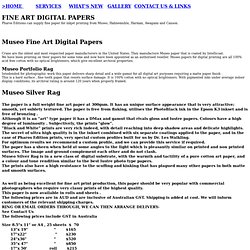
Museo Fine Art Digital Papers Crane are the oldest and most respected paper manufacturers in the United States. They manufacture Museo paper that is coated by Intellicoat. We have been printing on their papers for some time and now have been appointed as an authorised reseller. Museo papers for digital printing are all 100% acid free cotton with no optical brighteners, which give excellent archival properties. Media Types You Can Use. Last Updated : 05-Aug-2009 Issue Number : 8200567300 Choose paper suitable for printing, for the best print results.
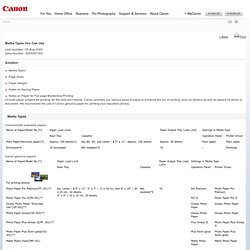
Canon provides you various types of paper to enhance the fun of printing, such as stickers as well as papers for photo or document. We recommend the use of Canon genuine paper for printing your important photos. Commercially available papers *1 Paper with a Model Number is Canon genuine paper. . *2 Proper feeding of paper may not be possible at the maximum capacity depending on the type of paper or environmental conditions (either very high or low temperature or humidity)
. *3 A4, B5, A5, or Letter-sized plain paper can be loaded only when Rear tray is selected for Plain paper feed settings in Device settings of the Settings menu. *4 Available only when printing from your computer. *5 Feeding this paper from the Cassette can damage the machine. Fine Art Paper, Drawing Paper, Watercolour Paper Australia. Incisioni (Italian for 'etching') is a soft and moderately sized and very smooth general purpose printmaking paper.
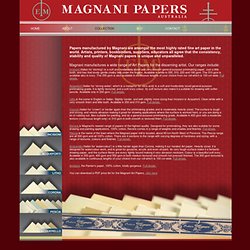
Just a little tooth, and has that lovely gentle chalky feel under the fingers. Available in white in 350, 310, 220 and 190 gsm. The 310 gsm is available also in ivory. The 350 gsm is also available in continuous lengths of your choice from our roll which is 100 cm wide. Full details. PIXMA MG8150. Museo Portfolio Rag 300gsm. Price (inc.

GST): Choose Options Below For Pricing Rating: Product Description (Often referred to as Crane Portfolio Rag) Museo's new archival matte paper is 100% cotton rag - and a serious alternative to something like Hahnemuhle's venerable Photo Rag, the king of this market. Museo Portfolio Rag is very smooth (distinctly smoother than Photo Rag), and contains absolutely no optical brighteners. Since Photo Rag first appeared years ago, many papers have tried to match it, but this is quite frankly the first serious alternative! Specifications Construction: Fibre Based Surface Type: Smooth Matte Compatible Inks: Plete Product Range & Data Sheet. What is a fine art giclee print? Process and techniques explained. Limited Edition Prints explained WHAT IS A FINE ART GICLEE PRINT?
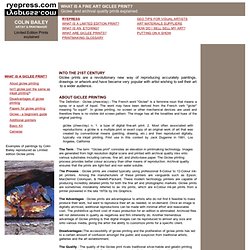
Giclee and archival quality prints explained I have been using the Epson R2400 for 7 years and have found it a very reliable and robust printer. For artists and photographers wishing to reproduce their work up to A3+ size the Epson Stylus Photo series are an economical and not too bulky solution. Alas the Epson R2400 is no longer made - (I was lucky to find a used one in good condition on Ebay last year) but I would recommend the latest in this line of giclee printers - the Epson Stylus Photo R3000 for anyone starting out with reproduction prints.
Learning how to price art prints is a significant challenge for visual artists. The advantage of Giclee printers is that they are capable of reproducing artwork and photographs on a wide range of surfaces including vinyl, canvas, and last but not least of course various weights and textures of paper and card.